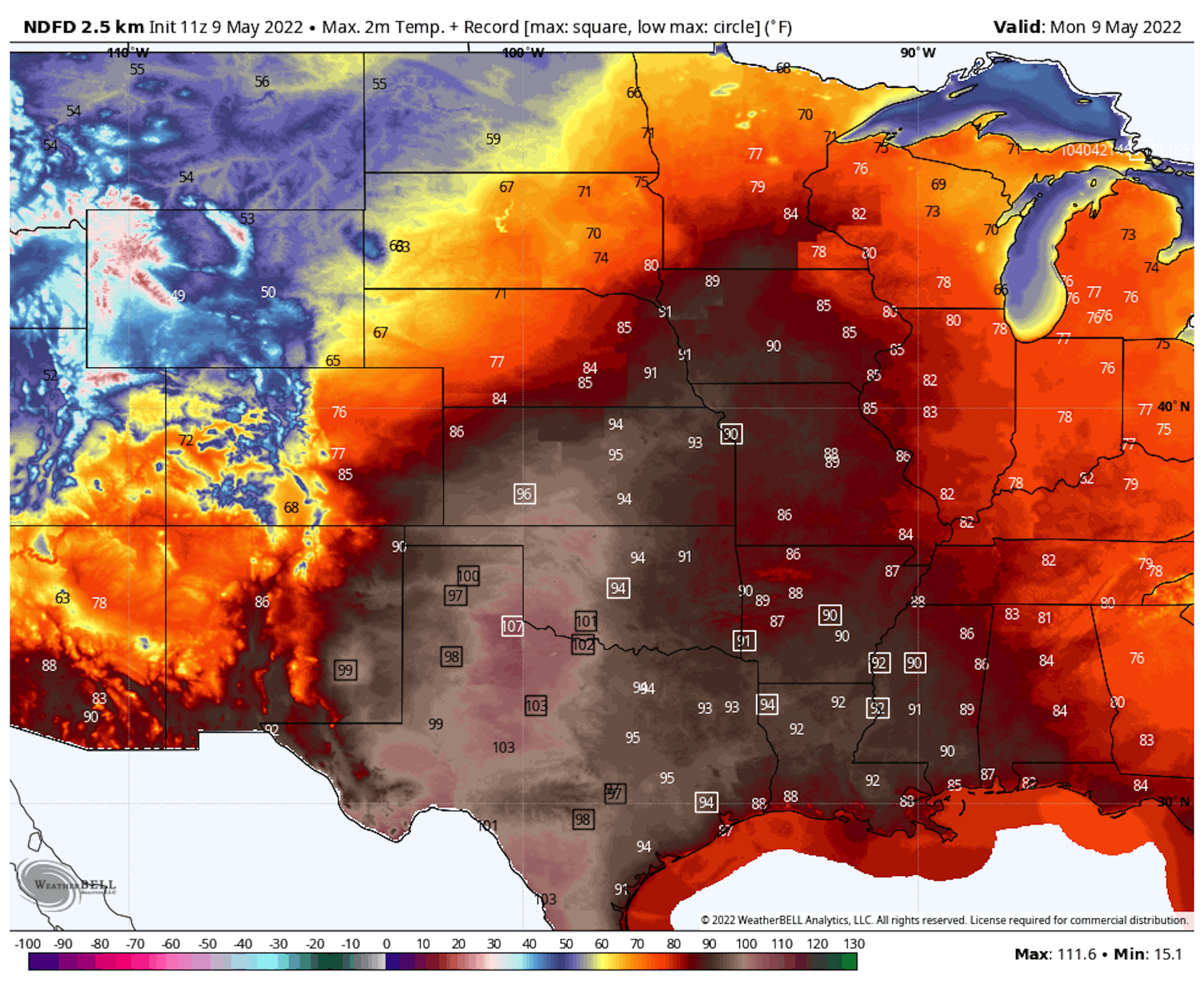The combination of a heat wave, long-term drought and relentlessly high winds is yielding a historically prolonged period of high wildfire risk across the Southwest. The fire danger may not significantly ease in New Mexico until Friday, according to the National Weather Service, which describes the situation as "dangerous and dire."
Why it matters: The wildfires and broader-scale heat wave threaten lives today, as any fires will spread rapidly.
- As a "heat dome" of high pressure expands north and east out of Texas, tens of millions will be exposed to temperatures in the 90s to triple-digits for the first time this year, when their bodies are not yet accustomed to it.
- This raises the risk of heat-related illness.
Threat level: Another day of "extremely critical" fire weather is on tap for northeastern New Mexico, as well as southeastern Colorado and western Oklahoma and Texas. This is the highest risk category, and the Weather Service forecast office in Albuquerque is describing the extreme conditions and their longevity as a "historic" event for the region.
Critical to extreme fire weather conditions continue today. Strong to damaging winds, very low humidity values and above normal temperatures are in store once again. We can't plead enough: Heed evacuations. Avoid causing sparks. Stay safe. #nmwx #nmfire pic.twitter.com/YWQfGjYZpN
— NWS Albuquerque (@NWSAlbuquerque) May 9, 2022
- A much larger portion of the Southwest is designated as being under "critical" risk today.
- New Mexico's second-largest wildfire on record, the Calf Canyon Fire, grew to 189,767 acres Sunday through Monday morning. Evacuations expanded from this fire Sunday evening as it made a wind-driven run to the northeast.
- To the west of the Calf Canyon blaze is the Cerro Pelado Fire, which is burning close enough to Los Alamos to prompt parts of the community to prepare for evacuations.
- The Storm Prediction Center is warning of "extreme fire behavior" today, which means it may be difficult or impossible for firefighters to contain these blazes, though they can make inroads in some areas.
The big picture: This is not the first time this spring that New Mexico and nearby states have contended with severe wildfires. Already, as many acres have burned in New Mexico as typically do in an entire year, due in large part to unusually high temperatures and severe drought conditions.
- As of May 5, 98.94% of the state was experiencing "moderate" to "exceptional" drought conditions, amid a broader drought affecting the Southwest and indeed the entire West.
- The wildfire threat this week is related to a series of storms riding along the jet stream across the central and northern Rockies. The counterclockwise circulation of air around these areas of low pressure has sparked a strong flow of air out of the west-southwest, transporting dry air into the region.
- Wind gusts in Arizona, New Mexico, northwest Texas and parts of Colorado have reached or exceeded the 40-60 mph range and are forecast to continue to do so.
By the numbers: The same weather pattern giving rise to the heightened wildfire risk is also prompting the heat wave.

- The extreme heat is unusual for early May, with three locations in Texas hitting 107 on Saturday, and Amarillo seeing its earliest-ever 100-degree reading (101). Similar readings were seen on Sunday, with Oklahoma increasingly sharing the heat.
- The heat wave will move into the lower Mississippi Valley and Southern Plains this week, before arriving in the Midwest. By the end of the week, 90-degree weather will reach Chicago.
Context: The heat wave, drought and wildfires are all connected, and climate change worsens all three.
- The Southwest is in the midst of its most severe and extended drought in at least 1,200 years.
- Studies show this drought is tied to human-caused climate change, as increasing temperatures dry out soils and plants faster, and alter weather patterns in ways that favor drought.
- In addition, research has also revealed that global warming is the main factor that is increasing wildfire risks in the West.
- A major UN climate science review published last August warned of the occurrence of “compound events,” in which various extremes, such as heat waves and drought, overlap and affect society in new and unpredictable ways.
Editor's note: This story has been updated with details on the Cerro Pelado Fire and the Calf Canyon Fire.







